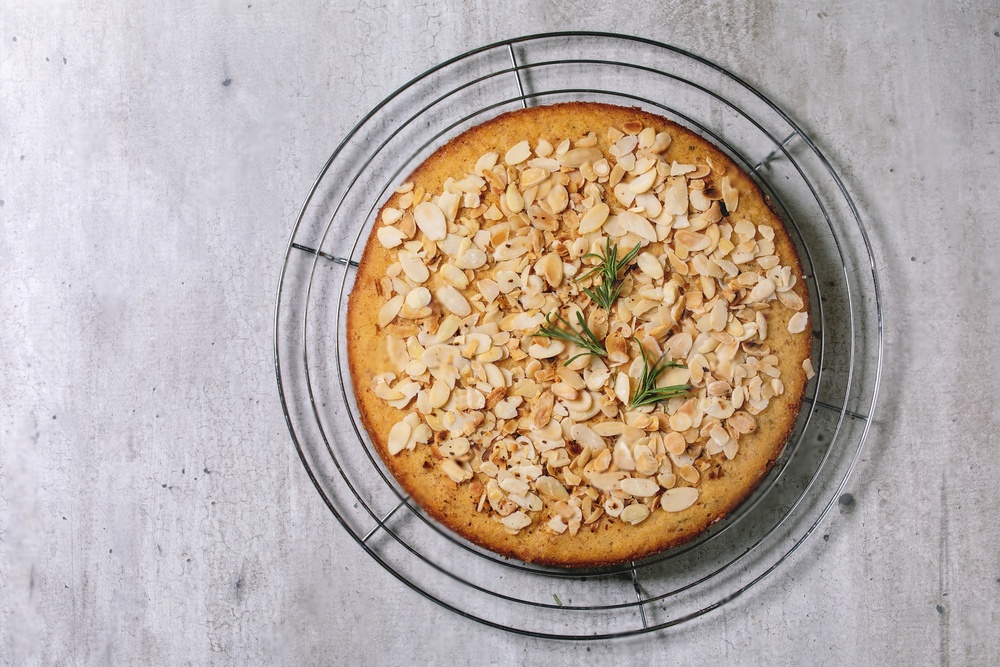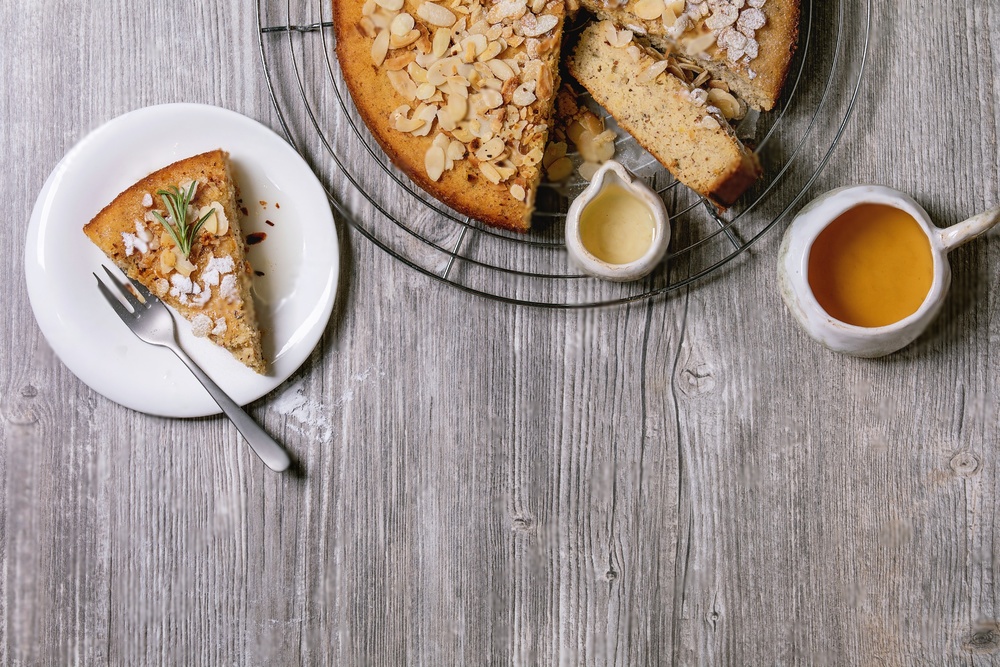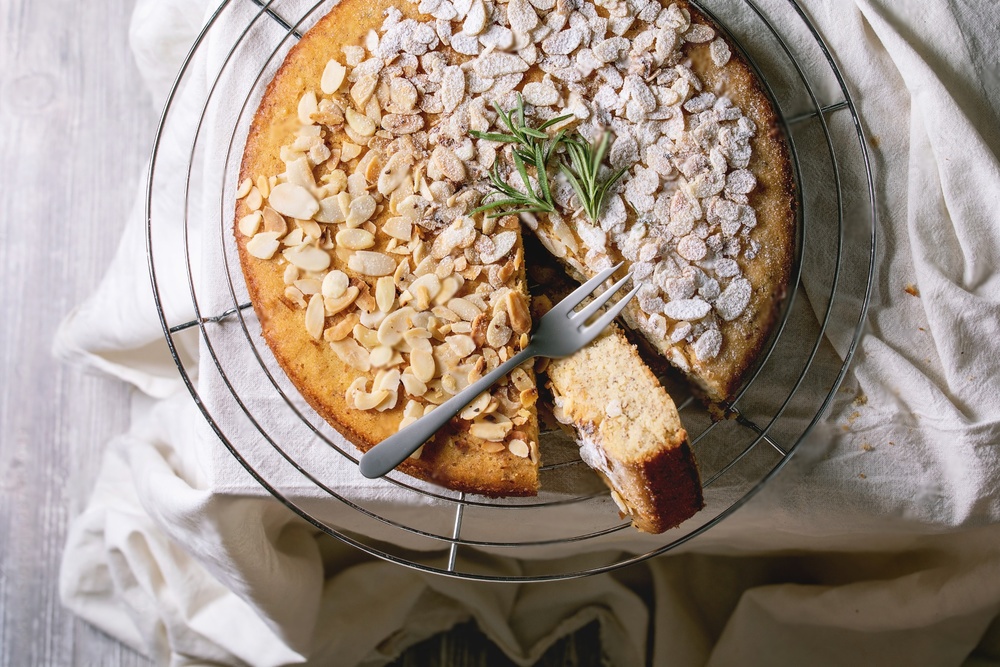Almond Cake
Almond Cake is a delightful treat that blends the nuttiness of almond flour with the delicate sweetness of light brown sugar and the fresh zest of lemon. This cake stands out with its moist, tender crumb and a slightly crunchy topping of flaked almonds, offering a truly indulgent experience. What sets this cake apart is its gluten-free composition, making it an excellent choice for those with dietary restrictions without compromising on taste or texture. Whether you’re catering to gluten-sensitive guests or simply seeking a cake with a unique flavor profile, this almond cake ticks all the right boxes. With its light, airy interior and rich, nutty notes, it’s a perfect centerpiece for any occasion.

Ingredients Overview
The secret to this cake’s irresistible texture and flavor lies in the careful selection of ingredients. Almond flour, the heart of the recipe, provides a subtle nuttiness and a moist texture that differentiates it from other cakes. This finely ground almond flour not only imparts a delicate taste but also adds a natural richness that pairs beautifully with the lemon zest.
The gluten-free flour blend ensures a perfect crumb structure without the need for traditional wheat flour. This blend, consisting of rice flour, potato starch, and maize flour, is carefully balanced to mimic the texture of regular flour, making the cake light and fluffy. If your blend contains xanthan gum, you can omit it from the recipe; otherwise, it plays a crucial role in binding the ingredients together.
Eggs and egg whites are essential to achieving the cake’s airy consistency. They provide the lift and structure needed, especially when whipped to the “ribbon stage,” creating a batter that is light yet stable. Flaked almonds on top add a delightful crunch and visual appeal, creating a beautiful golden-brown finish that tempts the eyes as much as the taste buds.
For those looking to make adjustments, dairy-free options such as almond milk and coconut yoghurt can be substituted for the milk and Greek yoghurt. To infuse even more flavor, consider adding a splash of vanilla extract, a few drops of almond essence, or a pinch of cinnamon or cardamom.
Step-by-Step Preparation Guide
Preparation is key to achieving the perfect almond cake. Start by ensuring your oven is correctly preheated to 350ºF (180ºC) and that the oven rack is positioned in the center. Proper pan preparation, using baking paper, is essential for a clean release and an evenly baked cake.
Whisking the eggs and sugar is perhaps the most crucial step. This stage involves beating the mixture until it’s pale, thick, and tripled in volume an indication that you’ve reached the ribbon stage. This term refers to the batter’s ability to fall in thick, ribbon-like folds when lifted. Achieving this stage sets the foundation for a light, airy cake, so take your time with this process, even if it takes up to 14 minutes with a hand mixer.
Once the eggs and sugar are perfectly whipped, the incorporation of wet and dry ingredients begins. Be sure to sift the dry components together to avoid any lumps, and fold them into the batter gently but thoroughly. When adding the melted butter, pour it in slowly with the mixer running. This method ensures that the butter emulsifies properly into the batter, creating a smooth, glossy consistency that bakes up beautifully.
When baking, keep a close eye on the cake. The almonds on top can brown quickly, so if they start to darken too much before the cake is fully baked, cover it loosely with aluminum foil. This little trick helps protect the almonds while allowing the cake to continue cooking evenly.

Recipe Tips & Frequently Asked Questions
- Tricks for Perfect Almond Cake Every Time: Avoid overmixing once the flour is added to prevent a dense texture. If you prefer a slightly gooey center, reduce the baking time by a few minutes for a more decadent finish.
- Common Mistakes to Avoid: Ensure all ingredients are at room temperature before starting. Cold eggs or butter can hinder the emulsification process, affecting the cake’s texture. If your cake sinks in the middle, it could be due to underbaking or opening the oven door too soon.
- Pro Tips: For an extra burst of flavor, try adding a pinch of salt to the almonds before sprinkling them on top. This contrast will elevate the overall taste of the cake.
- Why is my almond cake dense? Overmixing the batter or not whipping the eggs and sugar long enough can result in a denser texture. Ensure you achieve the ribbon stage for the best results.
- Can I make this cake dairy-free? Yes, you can substitute the whole milk with almond milk and the yoghurt with coconut yoghurt to make it dairy-free.
- How do I know when my cake is done baking? Insert a toothpick into the center; it should come out clean or with a few moist crumbs. If you want a fudgier texture, look for a toothpick with a touch of semi-baked batter.
- What if I don’t have a springform pan? A regular 8-inch cake tin lined with parchment paper will work, though removing the cake may be slightly trickier.
- Can I use regular flour instead of gluten-free? Yes, but it will no longer be gluten-free. Plain flour can be substituted in equal measure.
What to Serve With This Recipe
This almond cake pairs wonderfully with a variety of accompaniments. A dollop of freshly whipped cream or a spoonful of mascarpone can complement the cake’s lightness with a touch of richness. Fresh berries, such as raspberries or blueberries, add a vibrant pop of color and a tart contrast to the cake’s sweetness. Alternatively, a dusting of powdered sugar can provide a simple yet elegant finish.
For beverage pairings, consider serving this cake with a hot cup of coffee or a fragrant herbal tea. A light dessert wine or a crisp glass of Prosecco can elevate the experience, making it perfect for celebrations.

How to Store and Reheat Almond Cake
To keep your almond cake fresh, store it in an airtight container at room temperature for up to four days. If you wish to keep it longer, the cake freezes well; simply wrap it tightly in plastic wrap and place it in a freezer bag. When ready to enjoy, thaw the cake at room temperature and warm slices in the oven for a few minutes to revive its soft, fresh-baked texture.
Reheating can be done in a preheated oven at 300ºF (150ºC) for 5-10 minutes, depending on the thickness of the slices. This will restore the cake’s delicate crumb and enhance the almond aroma, making it taste just as delightful as when it was first baked.
Final Thoughts and Serving Suggestions
This almond cake is a must-try for anyone looking to indulge in a dessert that’s both elegant and comforting. Its balanced flavors and tender texture make it versatile for any occasion, from casual coffee breaks to special celebrations. Don’t hesitate to experiment with your own variations, such as adding dried fruit, chocolate chips, or a light glaze. No matter how you choose to enjoy it, this almond cake promises a slice of joy with every bite.

Almond Cake
Ingredients
- 113 g 1 stick unsalted butter, melted and slightly cooled
- 2 UK medium/US large eggs at room temperature
- 1 UK medium/US large egg white at room temperature
- 75 g ¼ cup + 2 tbsp caster sugar (or substitute with granulated sugar)
- 75 g ¼ cup + 2 tbsp light brown sugar
- Zest of 1 lemon
- 60 g ¼ cup whole milk, at room temperature
- 30 g 2 tbsp full-fat plain or Greek-style yoghurt, at room temperature
- 135 g 1 ⅓ cup almond flour or finely ground almonds
- 90 g ¾ cup plain gluten-free flour blend (I used Doves Farm Freee plain gluten-free flour; you can also create your own blend using 50% white rice flour, 30% potato starch, and 20% maize flour by weight.)
- 1 ½ tsp baking powder
- ½ tsp xanthan gum omit if your gluten-free flour blend already contains it
- ¼ tsp salt
- 90 g 1 cup flaked almonds
Instructions
- Begin by setting your oven rack in the center and preheating your oven to 350ºF (180ºC). Prepare an 8-inch (20 cm) springform pan by lining it with baking paper.
- In a large bowl or the bowl of a stand mixer fitted with a whisk attachment, combine the eggs, egg white, caster sugar, light brown sugar, and lemon zest. Beat the mixture on high speed for about 10 minutes or until the mixture becomes pale, thick, and triples in volume. Depending on your mixer, this may take up to 12-14 minutes, especially if using a hand mixer.
- Tip: When the mixture reaches the “ribbon stage,” the batter will form a ribbon-like trail on the surface when you lift the whisk.
- Add the milk and yoghurt, then briefly whisk until the ingredients are well incorporated.
- Sift in the almond flour, gluten-free flour blend, baking powder, xanthan gum, and salt. Mix thoroughly until the dry ingredients are fully integrated, and there are no remaining lumps of flour.
- With the mixer running on medium-high speed, gradually pour in the melted butter. Once the butter is fully combined, whisk the batter on high speed for an additional 20-30 seconds to achieve a smooth, silky consistency.
- Pour the prepared batter into the lined springform pan and smooth the surface evenly. Sprinkle the flaked almonds over the batter, ensuring the entire surface is covered and only a little cake batter is visible beneath the almond layer.
- Bake in the preheated oven for 45-50 minutes or until the cake is well-risen, a deep golden brown on top, and a toothpick inserted into the center comes out clean or with a few moist crumbs. If the almonds begin to brown too quickly, cover the cake loosely with aluminum foil (shiny side up) to prevent over-browning and continue baking.
- Tip: For a richer, more indulgent texture, consider slightly underbaking the cake by a few minutes. This method will create a soft, slightly fudgy center reminiscent of frangipane, contrasted by a cake-like outer layer. In this case, you’re looking for a toothpick to come out with a touch of semi-baked batter.
- Once baked, let the cake cool in the springform pan for 10-15 minutes. Carefully remove it from the pan and transfer it to a wire rack to cool completely or until it’s warm to the touch.
- This almond cake is best enjoyed warm or at room temperature.
Storage:
- Store the cake in an airtight container in a cool, dry place, where it will stay fresh for 3-4 days.
